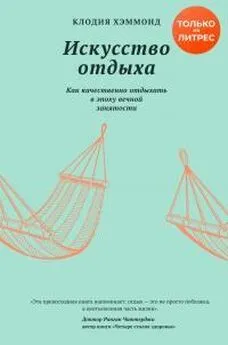Клодия Хэммонд - Искусство отдыха. Как качественно отдыхать в эпоху вечной занятости
- Название:Искусство отдыха. Как качественно отдыхать в эпоху вечной занятости
- Автор:
- Жанр:
- Издательство:неизвестно
- Год:2019
- ISBN:978-5-907056-51-0
- Рейтинг:
- Избранное:Добавить в избранное
-
Отзывы:
-
Ваша оценка:
Клодия Хэммонд - Искусство отдыха. Как качественно отдыхать в эпоху вечной занятости краткое содержание
Искусство отдыха. Как качественно отдыхать в эпоху вечной занятости - читать онлайн бесплатно ознакомительный отрывок
Интервал:
Закладка:
Вернуться
157
Matias, G.P. et al (2011) ‘Solitude and Cortisol: Associations with State and Trait Affect in Daily Life’. Biological Psychology, 86, 314–19
Вернуться
158
Long, C.R. & Averill, J.R. (2003) ‘Solitude: An Exploration of the Benefits of Being Alone’. Journal for the Theory of Social Behavior, 33 (1), 21–44
Вернуться
159
Russell, D.W. et al (2012) ‘Is Loneliness the Same as Being Alone?’. The Journal of Psychology, 146 (1–2), 7–22
Вернуться
160
Это из моего интервью для The Truth about Mental Health: Four Walls, BBC World Service, 16.06.2013
Вернуться
161
Markson, D. (1988) Wittgenstein’s Mistress. Illinois: Dalkey Archive Press
Вернуться
162
Bowker, J. (2017) ‘How BIS/BA and Psycho-behavioral Variables Distinguish Between Social Withdrawal Subtypes during Emerging Adulthood’. Personality and Individual Differences, 119, 283–8
Вернуться
163
Akrivou, K. et al (2011) ‘The Sound of Silence – A Space for orality? The Role of Solitude for Ethical Decision Making’. Journal of Business Ethics, 102, 119–33
Вернуться
164
Эксперимент BBC на тему одиночества был разработан Памелой Куолтер, Мануэлой Баррето и Кристиной Виктор. Результаты можно найти здесь: Hammond, C. (2018) ‘Who Feels Lonely? The Results of the World’s Largest Loneliness Study’. The Anatomy of Loneliness, BBC Radio 4, 01.10.2018. https://www.bbc.co.uk/programmes/articles/2yzhfv4DvqVp5nZyxBD8G23/who-feels-lonely-theresults-of-the-world-s-largest-loneliness-study
Вернуться
165
The Campaign to End Loneliness. ‘Is Loneliness a Growing Problem?’. https://www.campaigntoendloneliness.org/frequently-asked-questions/is-loneliness-increasing/
Вернуться
166
Valtorta, N.K. et al (2016) ‘Loneliness and Social Isolation as Risk Factors for Coronary Heart Disease and Stroke: Systematic Review and Meta-analysis of Longitudinal Observational Studies’. Heart, 102 (13), 1009–16
Вернуться
167
Hawkley, L.C. et al (2010) ‘Loneliness Predicts Increased Blood Pressure: 5 Year Cross-lagged Analyses in Middle-aged and Older Adults’. Psychology and Aging, 25 (1), 132–41
Вернуться
168
Holt-Lunstad, J. et al (2015) ‘Loneliness and Social Isolation as Risk Factors for Mortality: A Meta-analytic Review’. Perspectives on Psychological Science, 10 (2), 227–37
Вернуться
169
Heinrich, L.M. & Gullone, E. (2006) ‘The Clinical Significance of Loneliness: A Literature Review’. Clinical Psychology Review, 26 (6), 695–718
Вернуться
170
Cacioppo, J.T. et al (2010) ‘Perceived Social Isolation Makes Me Sad’. Psychology and Aging, 25 (2), 453–63
Вернуться
171
The interview I did with Barbara Taylor is in The Anatomy of Loneliness. BBC Radio 4, 02.10.2019. https://www.bbc.co.uk/programmes/m0000mj8
Вернуться
172
Mann, T. (1912) Death in Venice and Other Tales. London: Vintage Classic Europeans
Вернуться
173
Detrixhe, J. et al (2014) ‘A Lonely Idea: Solitude’s Separation from Psychological Research and Theory’. Contemporary Psychoanalysis, 50 (3), 310–31
Вернуться
174
Trevor, W. (2010) Felicia’s Journey. London: Penguin
Вернуться
175
Maes, M. et al (2016) ‘Loneliness and Attitudes toward Aloneness in Adolescence: A Person-centred Approach’. Journal of Youth Adolescence, 45, 547–67
Вернуться
176
Galanki, E.P. (2004) ‘Are Children Able to Distinguish Among the Concepts of Aloneness, Loneliness and Solitude?’ International Journal of Behavioral Development, 28, 435–43
Вернуться
177
Larson, R.W. (1997) ‘The Emergence of Solitude as a Constructive Domain of Experience in Early Adolescence’. Child Development, 68 (1), 80–93
Вернуться
178
Danneel, S. et al (2018) ‘Developmental Change in Loneliness and Attitudes toward Aloneness in Adolescence’. Journal of Youth Adolescence, 47, 148–61
Вернуться
179
Larson, R.W. (1997) ‘The Emergence of Solitude as a Constructive Domain of Experience in Early Adolescence’. Child Development, 68 (1), 80–93
Вернуться
180
Detrixhe, J. et al (2014) ‘A Lonely Idea: Solitude’s Separation from Psychological Research and Theory’. Contemporary Psychoanalysis, 50 (3), 310–31
Вернуться
181
Larson, R.W. (2014) ‘A Comparison of Positive and Negative Episodes of Solitude’. Master’s Thesis, Amherst: University of Massachusetts
Вернуться
182
Morris, C. (Ed.) (1949) The Journeys of Celia Fiennes. London: The Cresset Press, 67
Вернуться
183
Korpela, K.M. (2003) ‘Negative Mood and Adult Place Preference’. Environment and Behavior, 35 (3), 331–46
Вернуться
184
Jonson, S.A.K. (2011) ‘The Use of Nature for Emotional Regulation: Towards a Conceptual Framework’. Ecopsychology, 3 (3), 175–85
Вернуться
185
Можете послушать мое интервью с Ричардом Мэйби на All in the Mind. BBC Radio 4, 26.06.2012. https://www.bbc.co.uk/ sounds/play/b01k1nl3
Вернуться
186
Ulrich, R.S. (1984) ‘View Through a Window May Influence ecovery from Surgery’. Science, 224, 420–1
Вернуться
187
Ulrich, R. et al (1993) ‘Exposure to Nature and Abstract Pictures on Patients Recovering from Open Heart Surgery’. Psychophysiology: Journal of the Society for Psychophysiological Research, 30, S7
Вернуться
188
Отличный обзор немногочисленных исследований в этой области – Thompson, C.J. (2011) ‘Does Participating in Physical Activity in Outdoor Natural Environments Have a Greater Effect on Physical and Mental Well-being than Physical Activity Indoors? A Systematic Review’. Environmental Science & Technology, 45 (5), 1761–72
Вернуться
189
Lee, K.E. (2015) ‘40-second Green Roof Views Sustain Attention: The Role of Micro-breaks in Attention Restoration’. Journal of Environmental Psychology, 42 (2015) 182–9
Вернуться
190
Ulrich, R.S. (2008) ‘Biophilic Theory and Research for Healthcare Design’. In Kellert, S.R. et al (Eds) Biophilic Design: The Theory, Science and Practice of Bringing Buildings to Life. New Jersey: John Wiley
Вернуться
191
Lohr, V.L. & Pearson-Mims, C.H. (2006) ‘Responses to Scenes with Spreading, Rounded and Conical Tree Forms’. Environment and Behavior, 38, 667–88
Вернуться
192
Joye, Y. & Van den Berg, A. (2011) ‘Is Love for Green in our Genes? A Critical Analysis of Evolutionary Assumptions in Restorative Environments Research’. Urban Forestry & Urban Greening,10 (4), 261–8
Вернуться
193
Martens, D. et al (2011) ‘Walking in “Wild” and “Tended” Urban Forests: The Impact on Psychological Well-being’. Journal of Environmental Psychology, 31, 36–44
Вернуться
194
Parsons, R. (1991) ‘The Potential Influences of Environmental Perception on Human Health’. Journal of Environmental Psychology, 11, 1–23
Вернуться
195
Gatersleben, B. & Andrews, M. (2013) ‘When Walking in Nature Is Not Restorative – The Role of Prospect and Refuge’. Health & Place, 20, 91–101
Вернуться
196
Hagerhall, S.M. (2004) ‘Fractal Dimensions of Landscape Silhouette Outlines as a Predictor of Landscape Preference’. Journal of Environmental Psychology, 24, 247–55
Вернуться
197
Bratman, G.N. et al (2015) ‘Nature Experience Reduces Rumination and Subgenual Prefrontal Cortex Activation’. PNAS, 112 (28), 8567–72
Вернуться
198
Korpela, K. et al (2017) ‘Enhancing Wellbeing with Psychological Tasks Along Forest Trails’. Urban Forestry & Urban Greening, 26, 25–30
Вернуться
199
Richardson, M. & Sheffield, D. (2015) ‘Reflective Self-attention: A More Stable Predictor of Connection to Nature than Mindful Attention’. Ecopsychology, 7 (3), 166–75
Вернуться
200
Jamie, K. (2012) Sightlines. London: Sort of Books
Вернуться
201
Earth Science & Remote Sensing Unit High Definition Earth Viewing System. NASA, 30.04.2014. https://eol.jsc.nasa.gov/ESRS/HDEV/
Вернуться
202
Kaplan, R. & Kaplan, S. (1989) The Experience of Nature: A Psychological Perspective. Cambridge: Cambridge University Press
Вернуться
203
Ratcliffe, E. & Korpela, K. (2017). ‘Time- and Self-related Memories Predict Restorative Perceptions of Favorite Places Via Place Identity’. Environment and Behavior, 50 (6), 690–720
Вернуться
204
Wyles, K.J. et al (2017) ‘Are Some Natural Environments More Psychologically Beneficial than Others? The Importance of Type and Quality on Connectedness to Nature and Psychologica Restoration’. Environment and Behavior, 51 (2), 111–43
Вернуться
205
Van den Berg, A. et al (1998) ‘Group Differences in the Aesthetic Evaluation of Nature Development Plans: A Multilevel Approach’. Journal of Environmental Psychology, 18, 141–57
Вернуться
206
Diener, E. et al (2009) ‘New Well-being Measures: Short Scales to Assess Flourishing and Positive and Negative Feelings’. Social Indicators Research, 97, (2), 143–56
Вернуться
207
Nell, V. (1988) ‘The Psychology of Reading for Pleasure: Needs and Gratifications’. Reading Research Quarterly, 23 (1), 6–50
Вернуться
208
Четыре красные стороны и восемь белых.
Вернуться
209
The Sleep Council (2013) The Great British Bedtime Report. Published by the consumer education arm of the trading body for bed manufacturers.
Вернуться
210
Rizzolo, D. et al (2009) ‘Stress Management Strategies for Students: The Immediate Effects of Yoga, Humor, and Reading on Stress’. Journal of College Teaching and Learning, 6 (8), 79–88
Вернуться
211
Jin, P. (1992) ‘Efficacy of Tai Chi, Brisk Walking, Meditation, and Reading in Reducing Mental and Emotional Stress’. Journal of Psychosomatic Research, 36 (4) 361–70
Читать дальшеИнтервал:
Закладка:










